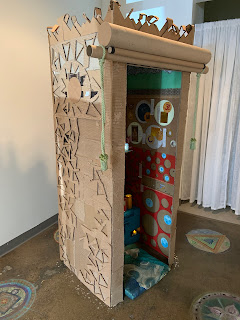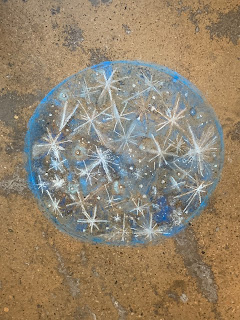Street Shrine I: Love without Power/Power without Love
Street Shrine I: Love without Power/Power without Love
An image of the inside of the shrine. All blog post photos: Robin L. Snyder
Street Shrine I: Love without Power/Power without Love was inspired by Martin Luther King's Dr. Martin Luther King's speech "Where Do We Go From Here?" Annual report, delivered at the 11th Convention of the Southern Christian Leadership Conference, August 16, 1967. Atlanta, GA.
Street Shrine I: Love without Power/Power without Love is dedicated to the existence and function of our pineal gland - allowing us to connect with the divine.
Materials: Cardboard freezer box, recycled cardboard boxes, cardboard design remnants from laser-cut patterns, paint, Dollar Store decorative bling, plastic & metal religious icons, paper information scrolls, pine cones, recycled jewelry, plastic candles, pillow covered in vintage remnant fabrics.
Concept and inspiration:
The first time I encountered a person living on the street was during a trip to work an arts and crafts fair in downtown Manhattan in the mid-seventies. My employer warned me not to disturb anyone I might encounter lying on the street. She warned me that these folks wished not to be disturbed and suggested I just mind my own business. Sure enough I did encounter people sleeping in doorways and one person in particular who I had to walk around, as they were sleeping on the sidewalk with a large sheet of cardboard covering them. I have never forgotten that experience. Encountering a human being sleeping on a city sidewalk with cardboard providing a bit of shelter for them as they slept.
Thinking of Dr. King's speech about the concepts of power and love, and thinking about how we make contact with such love and power, I asked myself, what might a make shift street shrine look like? How would it be decorated if years of time, great artistic skill and precious materials were not available to the maker? What if such a shrine could be light weight and portable - easy to move from place to place?
Every culture on Earth, every religion, has some sort of container constructed for worship, some sort of structure, whether it be a temple, a shrine, a church, or simply an outdoor sacred space such as a cave or a mountain top. If a culture does not build containers or structures of worship, every culture does have some sort of ritual that they perform to connect to the divine, whether the divine be considered reachable though prayer to energies contained in nature or by reaching into other realms of existence.
The connection they all share however, whether in structures (containers) or during ritual, is the sense of love contained in each. Whether that is a love for a one, true source (God), or that source individualized into many entities (gods and goddesses). We have faith that we can connect and we feel love for a God, gods and goddesses that we can communicate with through prayer and meditation. And the little tiny gland found in the middle of our brains, the pineal gland, seems to be the reason we are able to do so.
Materials and process:
The basic form of Street Shrine I is recycled freezer shipping box. The exterior of Street Shrine I is decorated with negative space patterns on cardboard sheeting, created by another artist for her sculptures (made of beautifully stacked cardboard cutouts). I asked her if I may have the sheets of cardboard with the shapes she had laser cut out to use for Street Shrine I, then tore the layers of the cardboard sheets apart to reveal the patterns of the cardboard material itself - textured with ripples of paper. I used the negative space patterns cut out of the cardboard on the inside of the Shrine too, but left the sheets intact ( didn't tear them apart).
Inside Street Shrine I visitors will find a hand painted ceiling of stars and tiny metal stars. The cutout in the center of the ceiling allows both light from above to shine into Street Shrine I and for visitors to see a crown of pinecones encircling the outside rim - referencing our pineal gland and its function.
The walls are decorated with the symbols of various mainstream religions ranging from Judaism, Islam and Christianity to symbols held sacred in other spiritual practices such as Hinduism and Wicca. There are also astrological symbols and symbols given to us as gifts from extraterrestrials. Shrine's altar in the center holds various small sculptures of religious icons such as St. Mary, Quan Yin, Buddha and Ganesh with the symbol of the sacred egg sitting atop an inner shrine holding a large decorated pine cone that again references our pineal gland. The ceiling of this inner shrine is decorated with star and moon charms.
There are references to our moon's phases, plastic twinkling candles and flowers adorning the corners of Shrine. On the floor, a foam pillow encased in scraps of vintage fabrics, meant for kneeling in front of the second Pineal Shrine. For those who may find difficulty kneeling, one can bend a bit to see inside the the second shrine more closely.
I ask that only two visitors at a time come into Street Shrine I: Love without Power/Power without Love to allow for a careful and quiet experience of the work. I hope my discussion here has been helpful information and I thank you for reading it and visiting my installation.



















Comments
Post a Comment